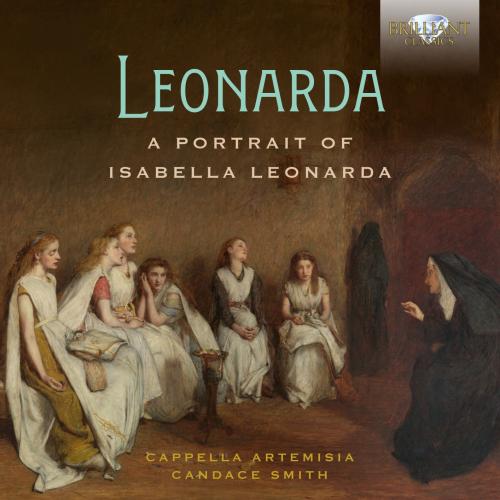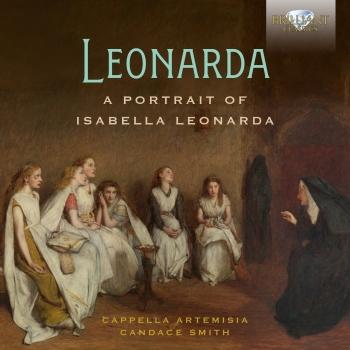
Leonarda: A Portrait of Isabella Leonarda Cappella Artemisia & Candace Smith
Album info
Album-Release:
2022
HRA-Release:
26.08.2022
Label: Brilliant Classics
Genre: Classical
Subgenre: Choral
Artist: Cappella Artemisia & Candace Smith
Composer: Isabella Leonarda (1620-1704)
Album including Album cover Booklet (PDF)
- Isabella Leonarda (1620 - 1704): Gloriosa mater domini à 4 (From sacri concenti a 1, 2, 3, et 4 voci, Op. 3, Milan 1670):
- 1 Leonarda: Gloriosa mater domini à 4 (From sacri concenti a 1, 2, 3, et 4 voci, Op. 3, Milan 1670) 07:34
- Memento rerum à 4 a cappella (From sacri concenti a 1, 2, 3, et 4 voci, Op. 3, Milan 1670):
- 2 Leonarda: Memento rerum à 4 a cappella (From sacri concenti a 1, 2, 3, et 4 voci, Op. 3, Milan 1670) 02:46
- Salve regina for Solo Soprano and 2 Violins (From Motetti a 1, 2, e 3 e 4 voci, parte con istromenti, Op. 7, Bologna 1677):
- 3 Leonarda: Salve regina for Solo Soprano and 2 Violins (From Motetti a 1, 2, e 3 e 4 voci, parte con istromenti, Op. 7, Bologna 1677) 09:08
- In caelis gloria à 4 (From Motetti a una, due, e tre voci, con violini e senza, Op. 13, Bologna 1687):
- 4 Leonarda: In caelis gloria à 4 (From Motetti a una, due, e tre voci, con violini e senza, Op. 13, Bologna 1687) 09:57
- Sonata No. 9 for 2 Violins (From Sonate a 1,2,3, e 4, Istromenti, Op. 16, Bologna 1693):
- 5 Leonarda: Sonata No. 9 for 2 Violins (From Sonate a 1,2,3, e 4, Istromenti, Op. 16, Bologna 1693) 04:15
- O flammæ for Solo Soprano (From mottetti a voce sola, parte con due violini, e parte senza, Op. 6, Venice 1676):
- 6 Leonarda: O flammæ for Solo Soprano (From mottetti a voce sola, parte con due violini, e parte senza, Op. 6, Venice 1676) 09:50
- O dulce sonare for 3 Voices and 2 Violins (From motetti a 1, 2, e 3 e 4 voci, parte con istromenti, e parte senza, Op. 7, Bologna 1677):
- 7 Leonarda: O dulce sonare for 3 Voices and 2 Violins (From motetti a 1, 2, e 3 e 4 voci, parte con istromenti, e parte senza, Op. 7, Bologna 1677) 07:32
- O anima mea (From Dresden Mus. 1737-E.500 & Uppsala Mus: Hs.28:1, arranged for 2 Altos and 4 Viols by Daniel Speer, Philomela Angelica, Venice 1688):
- 8 Leonarda: O anima mea (From Dresden Mus. 1737-E.500 & Uppsala Mus: Hs.28:1, arranged for 2 Altos and 4 Viols by Daniel Speer, Philomela Angelica, Venice 1688) 06:47
- Dialogo:
- 9 Leonarda: Dialogo: Quo pergis anima à 4 (From sacri concenti a 1, 2, 3, et 4 voci, Op. 3, Milan 1670) 07:43
- Dixit dominus for 4 Voices and 2 Violins (From Salmi Concertati a 4 voci con strumenti, Op. 19, Bologna 1698):
- 10 Leonarda: Dixit dominus for 4 Voices and 2 Violins (From Salmi Concertati a 4 voci con strumenti, Op. 19, Bologna 1698) 08:35
Info for Leonarda: A Portrait of Isabella Leonarda
Highlights from the varied output of a prolific female 17th-century composer.
Born into a noble family, Isabella Leonarda (1620-1704) entered the Ursuline Convent in the Piedmontese city of Novara at the age of 16. Having taken holy orders she lived there for the rest of her life as a religious sister, though the relatively liberal code of the Ursulines as a teaching order enabled her to travel from time to time. In due course she became the director of music in the convent and its Mother Superior. She evidently showed musical promise from an early age, further nurtured within the convent, as the first of her published collections of music dates from as early as 1640, when she was just 20 years old.
Another 15 such collections followed over the course of her long and industrious life: Masses, psalms, Magnificats, responsories, hymns, antiphons and litanies) as well as non-liturgical pieces. In her own time, Isabella’s music was prized by connoisseurs: according to one French collector, ‘All the works of this illustrious and incomparable Isabella Leonarda are so beautiful, so charming, so brilliant, and at the same time so knowledgeable and so wise ... that my great regret is not to have them all.’
This recording provides a portrait of Isabella Leonarda’s vast and varied output, ranging from solo motets to a large-scale Psalm setting for voices, obbligato violins and basso continuo. O flammae is a highly expressive and sensual solo motet involving daring chromaticism and far-ranging tonalities. Previous recordings of the brilliant Salve Regina, scored for tenor, violins and continuo, have employed a male voice, whereas the all-female Capella Artemisia takes the kind of imaginative approach to performance that Isabella would have devised for herself in the convent out of necessity, where lower vocal parts would have been either transposed up or played on instruments. The album opens and closes with a pair of her most splendid and exuberant concerted liturgical works, Gloriosa Mater Domini and Dixit Dominus.
As a whole, the album should open many ears to an overlooked but major figure of 18th-century sacred music. It should invite the same warm critical reception given to the previous releases of Capella Artemisia on Brilliant Classics: ‘Lacrime Amare’ (95736, motets by Bianca Maria Meda) and ‘Weep and Rejoice’ (94638, music for Holy Week from 17th-century Italian convents). ‘Brilliant Classics is to be congratulated for bringing this (and other) hidden treasures of the Baroque to audiences, and in the capable expert hands of the Cappella Artemisia, Meda’s fine music can come alive. This is one disc well worth acquiring.’ (Fanfare on ‘Lacrime Amare’)
Suor Isabella Leonarda (1620-1704) was the most prolific woman composer of the 17th century. She published no fewer than 20 collections of motets and other sacred music, nearly 200 compositions spanning virtually every genre of sacred music of her time, as well as the only complete collection of instrumental works by an Italian woman in the 1600s. This recording is a tribute to her artistry.
Born and baptized as Anna Isabella Leonardi on 6 Sept. 1620, she belonged to one of the most illustrious families of Novara. She studied at home before entering the Congregazione delle Vergini di S. Orsola at age 16. She took her vows three years later and remained in this convent until her death on February 25, 1704, at the age of 84. During her long life, Isabella served in all capacities: mater discreta et cancellaria, magistra musicae, superiora, and finally consigliera. She was clearly a woman of robust constitution and an iron will.
This recording provides a portrait of Isabella Leonarda’s vast and varied output, ranging from solo motets to a large-scale Psalm setting for voices, obbligato violins and basso continuo. Numerous works exemplify her “concertato” writing in their alternation of meter, tempo and texture between florid soloistic passages and more homophonic choral treatment. The absence of male voices is solved by the transposition of lower voices or the use of instruments.
Cappella Artemisia, founded by Candace Smith in 1991, is an ensemble of women dedicated to performing the music of Italian convents of the 16th and 17th centuries. The repertoire includes both forgotten works composed by the nuns themselves, and music intended for performance in the convents by male composers, but presented as it would originally have been heard, i.e., without male voices. The musicians are all established performers in the field of early music and actively collaborate with other ensembles.
Cappella Artemisia
Candace Smith, direction
Cappella Artemisia
is an ensemble of female singers and instrumentalists that attempts to provide some answers to this question. Dedicated to performing the music from Italian convents in the 16th and 17th centuries, its repertoire includes both forgotten works composed by the nuns themselves, as well as music intended for performance in the convents by better-known male composers, but presented here for the first time as it would originally have been heard, i.e., without male voices.
Since its inception in 1991, Cappella Artemisia has received critical and popular praise both for the rarity and originality of its repertoire and for the high quality of its performances. It has appeared at some of the most prestigious European and North American festivals of early music and its concerts and recordings have been broadcast on radios throughout Italy, Europe and North America. The ensemble has ventured into the 18th century with the first performance in modern times of the oratorio Jahel by Baldassare Galuppi, composed for the girls of the Venetian Ospedale dei Mendicanti (in collaboration with the Orchestra Barocca di Bologna). And in addition to their traditional repertoire of music from Italian convents, the singers of the ensemble were also involved in a modern staging of Purcell’s Dido and Aeneas in an all-women’s performance recalling that of 1689 at a fashionable boarding school in Chelsea for “Young Gentlewomen”.
Cappella Artemisia takes its name from the painter, Artemisia Gentileschi, a striking figure in 17th-century Italy whose artistic accomplishments are finally beginning to be recognized. We hope, under her auspices, to bring this same recognition to the neglected musical achievements of her forgotten contemporaries within the convent walls.
Booklet for Leonarda: A Portrait of Isabella Leonarda









